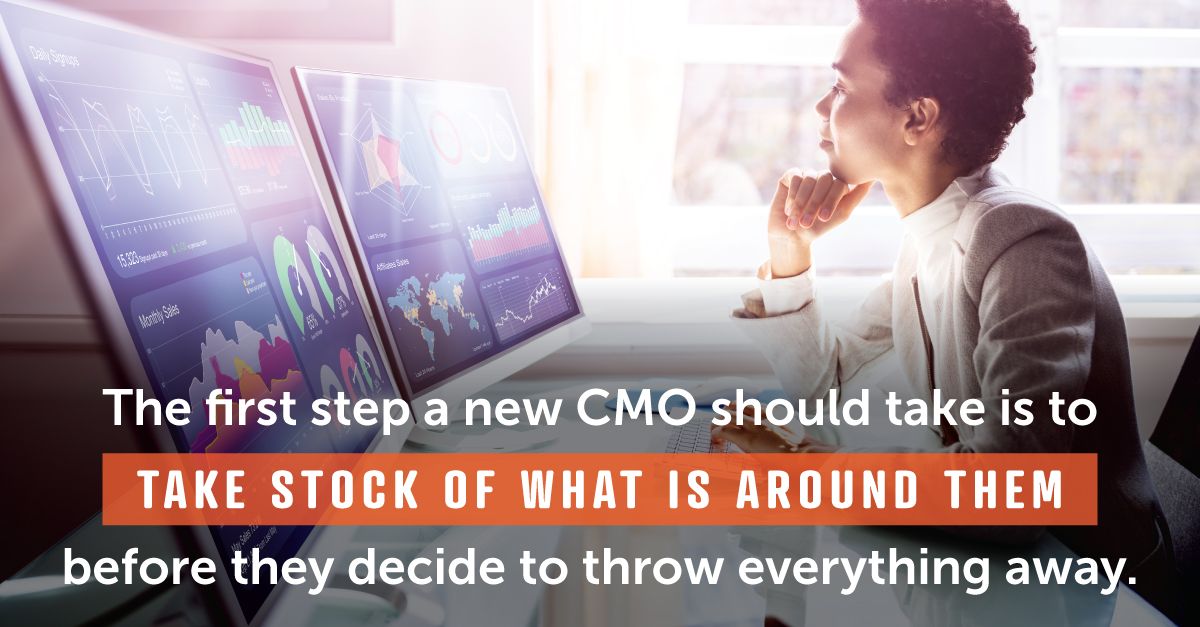
Much to the dismay of advertising and marketing agencies, when they hear that their client has a new Chief Marketing Officer (CMO) or high-level marketing manager, they know that there is about to be a serious change. This news will ultimately mean that the new CMO, trying to make swift changes in the eyes of the rest of the C-suite in a radical departure from their predecessor, will clean house and look for a new direction. The idea may align with the emotions that a new CMO may feel stepping into the world of their predecessor, but it may not be the best plan for them or the company.
While drastic changes will certainly create a difference in the direction from the previous CMO, the first step a new CMO should take is to take stock of what is around them before they decide to throw everything away. This would be like not checking a building before demolishing it after you bought the lot. Yeah, that building may not be completely sound, but you at least need a thorough evaluation of what’s inside before tearing it down.
Making the right decision about the company’s future of marketing should be made after carefully considering the state in which it is already. Otherwise, the decision gets made on emotion rather than fact. How to stand out as a new CMO is by reevaluating what the company’s current marketing efforts are, learning what each vendor does and why the company initially went with that vendor. If you do not understand the significance of something, throwing it away, while easy, is premature. Here are the steps we believe should be taken before any drastic changes are made:
Learn Current Vendors
Take the time to learn about each vendor. What do they do, and what are their strengths? Assessing each vendor in this way explains how they have helped (or hindered) the company’s growth and gives the new CMO an understanding of the connection the vendor has with the brand, and their competence.
Learn Current Vendors Example
For example, Vendor A may specialize in job title database targeting for social media ads, while vendor B specializes in affinity audience targeting for in-stream video ads. This will help you know what area each vendor specializes in so you can evaluate them on their specialty versus a new vendor that has a similar specialty.
Evaluate Current Implementation of the Company and its Vendors
After carefully evaluating what historically was done, and the agreements, methodology, and performance of a particular vendor, a new CMO should test the data in front of them with a split test or an A/B test. Meaning, they should take two vendors who both specialize in the same area, targeted display ads for example, and make all things equal between the two vendors, running virtually identical campaigns with each so that they can determine which yields better results.
Example: Split Testing Vendors
An example of this would be continuing to run with vendor A at a $10,000 budget for display ads, and not telling them you are running the exact same campaign, creative and budget with vendor B over the same time period.
Split Test Current Vendors vs New Proposed Vendors

Split tests should create an equal playing field between both potential vendors who are being considered so that it is a fair test based on understandable and measurable key performance indicators (KPI’s). Lastly, the test should be tracked and have the “winner” decided based on purely conversion results from a full view through the attribution system. We don’t recommend telling the vendors about the test. This way, they will continue to perform as they have and not be tempted to manipulate data in their favor … yes we have actually seen it happen too many times when we were the new vendor.
Ignoring the strengths of a previous vendor in favor of a new one, without a test, would require a new CMO to take a blind leap of faith that they made the right decision, with no data. Data-driven decisions will always be more effective and impressive. Just because a new CMO is not bringing any new vendors to the table, it does not mean they are not contributing anything new. If they still feel the need to make a splash and shake things up after finding out current vendors are working effectively, there are some more effective steps they may take:
Search for Efficiency Increases
The new role does not need to mean clearing house, but rather cleaning house by cleaning up processes. Whether it be in communication work flows with current vendors, or processes that can be streamlined in other assets of marketing, search to find ways to make your marketing department more efficient in ways you can control.
Evaluate Branding and Creative
Work with internal and external teams to evaluate all branding, ads, and so forth to see if things need to be freshened up. While you are at it, work with your vendors to ensure safe brand and ad placement, so you are on “safe for work” (SFW) types of sites that are also trustworthy and that avoid ad fraud.
Evaluate the Message
Make sure that the message your company is working so hard to promote is the right one. All too often companies will spend millions of dollars in advertising for a message that just does not resonate with the audience. A good CMO should poll their audience and split test ideas to find out what messaging is really working.
New CMOs are always eager to jump in with both feet and develop their own ideas and practices. In doing so, however, it’s imperative that they study carefully what has been effective, and what has not.



